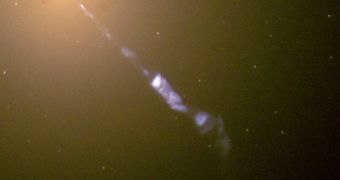Gamma-ray Bursts (GRB) are arguably among the deadliest phenomena that can take place in the Universe. Believed to be generated in the dying throes of massive stars, these emissions exit the stars as jets of plasma, which then proceed to traveling billions of light-years in all directions. The high-energy particles that make up these jets are very similar to the elements that are produced when a nuclear bomb goes off, only on an infinitely larger cale. Astronomers have been wondering about the exact cause of these events for many years, and now a team of investigators proposes a new explanation.
According to UK mathematicians at the University of Leeds (UL), it may be that these jets originated directly in black holes, which have the ability to essentially dive into massive stars, and consume them. This new explanatory model directly opposes existing theories about GRB formation, which hold that the radiation originates in the disk matter surrounding a freshly created black hole. When a massive star collapses, its core contracts, but a disk of matter remains around it. Astronomers believe that neutrinos heat plasma inside the disk, and that the plasma is then released as a GRB.
ScienceDaily reports that the team's new theory is based on the most recent scientific observations of this phenomenon, taken with the Swift satellite. Measurements from this instrument have revealed that the central jet engine operates for about 10,000 seconds, which is a lot longer than the neutrino model can account for. This disparity, the UL experts believe, can only be explained if an electromagnetic origin is given for the jets. Their speed and focus could therefore be generated by the hole's spin.
“The neutrino model cannot explain very long gamma ray bursts and the Swift observations, as the rate at which the black hole swallows the star becomes rather low quite quickly, rendering the neutrino mechanism inefficient, but the magnetic mechanism can. Our knowledge of the amount of the matter that collects around the black hole and the rotation speed of the star allow us to calculate how long these long flashes will be – and the results correlate very well with observations from satellites,” UL School of Mathematics Pofessor Serguei Komissarov explains.
A paper describing the new finds, entitled “Close Binary Progenitors of Long Gamma Ray Bursts,” can be found in the latest issue of the scientific journal Monthly Notices of the Royal Astronomical Society. The research was funded by the UK Science and Technology Facilities Council.

 14 DAY TRIAL //
14 DAY TRIAL //